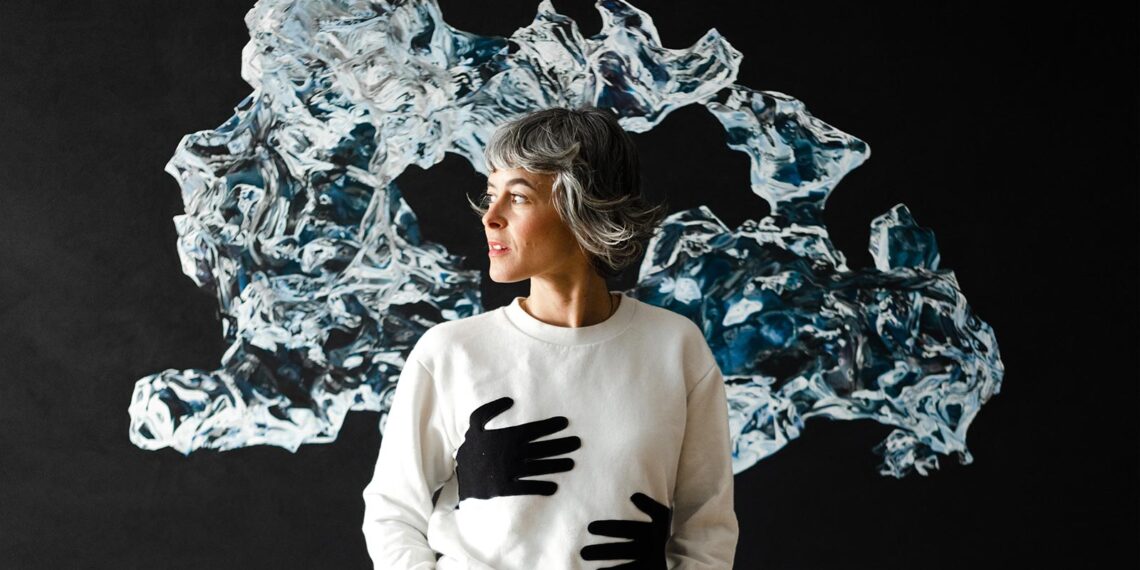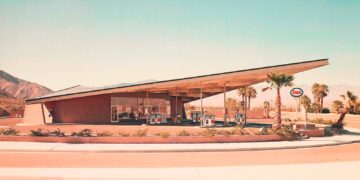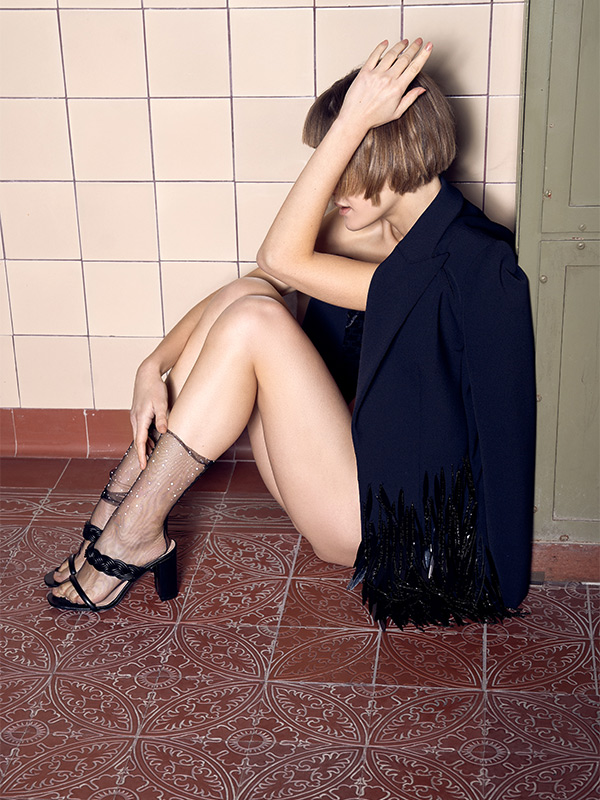While others groan in the icy temperatures, Zaria Forman’s eyes sparkle like the ice crystals on Iceland’s Diamond Beach in the sunlight. The American artist drew inspiration from them for the art she created in collaboration with Vacheron Constantin for its Overseas Collection.
FACES: You earn your living as an artist and adventurer. How did you manage that?
Zaria Forman: The foundation for what I do today lies in my childhood. Back then, I traveled with my family to some of the most remote places in the world and got to see the most incredible landscapes. My mother then turned the latter into art as a photographer. My mother’s work inspired me to create my own art, as it taught me to understand and appreciate the beauty and vastness of the ever-changing sky or the power of the waves of the sea. I loved watching a desert storm from afar, experiencing the monsoon rains in southern India or seeing the cold arctic light illuminating the waters in Greenland. The memory of our family trips makes me happy, and I see them as an important part of my upbringing and education. It was great that I had the opportunity to see so much of the world at such a young age and learn about foreign cultures at first hand. It is these experiences that have sparked my love of exploring the world. My art is the result of all my discoveries and adventures.
FACES: What fascinated you most about the landscapes of Iceland that you visited for the collaboration with Vacheron Constantin?
Zaria Forman: I was particularly fascinated by Fellsfjara beach, also known as Diamond Beach. The broken ice of the glaciers collects on black sand, while white foaming waves splash against the shore. The warm sunlight hits the interlocking ice crystals, through the various frozen layers and the air bubbles and cracks, creating an incredible play of light if you take the time to look. In fact, these rivulets and cavities are the physical evidence of rising air and sea temperatures affecting the ice and bringing it to this current, unstable form.
Big city feeling
FACES: You live in New York and constantly travel around the world for your work. Doesn’t the stressful big city clash with the tranquillity of these remote places?
Zaria Forman: A few years ago, I decided to leave New York City and move further north. Here I finally have that access to nature that I missed during my time in Brooklyn. I love being outside and watching my daughter explore nature and observe the landscape as the seasons change. My view of the rolling hills of the surrounding nature is one reason why I wanted to build my studio here, which I am currently building. However, I also love the hustle and bustle of New York City, and I am drawn back there again and again. The almost monthly visits and being together with my friends, the art, the culture and the many opportunities to eat great food help me to recharge my batteries.
FACES: Art has many faces: your work with colors on canvas is just as much art as watchmaking. How can these two things be compared?
Zaria Forman: The precision of Vacheron Constantin’s movements can perhaps be compared to my work of art, which was inspired by the ice in Iceland. I spent hours watching the ice forming and melting so that I could reproduce its movement exactly in my work. Watches have the task of displaying the time reliably and constantly – there is no room for error. With the landscapes I draw, it’s exactly the opposite: they are constantly changing, and although they appear large and powerful, they are extremely fragile. My art captures the beauty of this transience and what humanity risks losing because of its actions. Nevertheless, time is a crucial component of my work. After all, a glacier can take up to several million years to form in the first place. In that fraction of a second when the sunlight hits an iceberg, this magic is created that I try to capture on canvas. And I sometimes work on capturing that one second for weeks and months.
The collaboration with Vacheron Constantin
FACES: For the collaboration with Vacheron Constantin, you focused on glaciers, ice, water and waves. What fascinates you so much about the element of water and its manifestations?
Zaria Forman: It may seem as if glaciers have nothing to do with our everyday lives, but in fact they influence all living things on our planet. On the one hand, they regulate global temperatures as a worldwide cooling system. They cover around ten percent of the Earth’s surface and store around 75 percent of all the world’s freshwater reserves. Ice cream is an inexhaustible source of inspiration for me because there are so many forms of it. There are so many different surfaces and textures, and inside it, cracks, bubbles and light write their very own story. There is still so much we can learn about ice and glaciers, and I don’t think I will ever stop thinking about how to capture their play through my art.
FACES: The new Overseas Collection from Vacheron Constantin represents the spirit of adventure. How do you bring your hunger for adventure to the screen?
Zaria Forman: The collaboration with Vacheron Constantin fits like a glove. In my art I process my travels to remote places around the world and the experiences and impressions I gather there. Most of the landscapes I draw are difficult to reach, which is why I am keen to pass on my experiences as best I can.
FACES: And to what extent do the watches in the Overseas collection exude the scent of adventure?
Zaria Forman: These models are the perfect travel companions. They are practical, elegant and adapt to any occasion thanks to their interchangeable straps. Watches are the perfect tool for discovering the world.
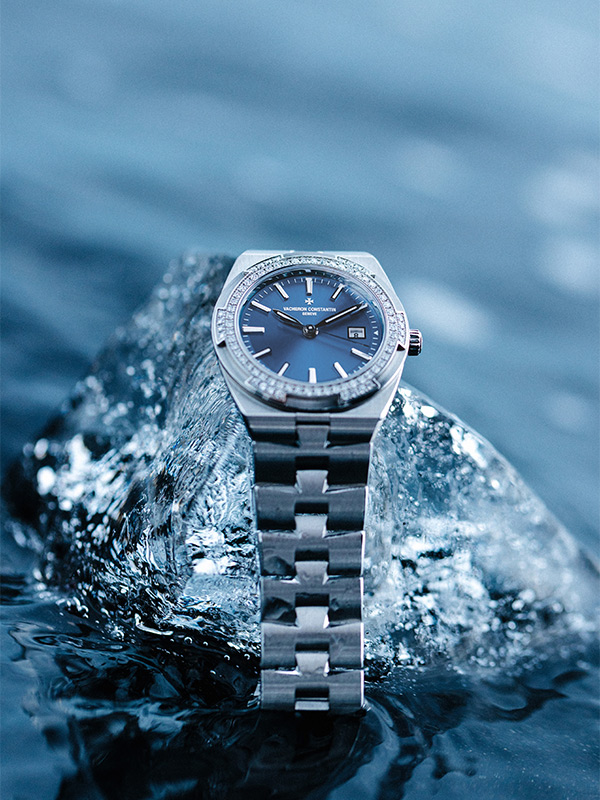
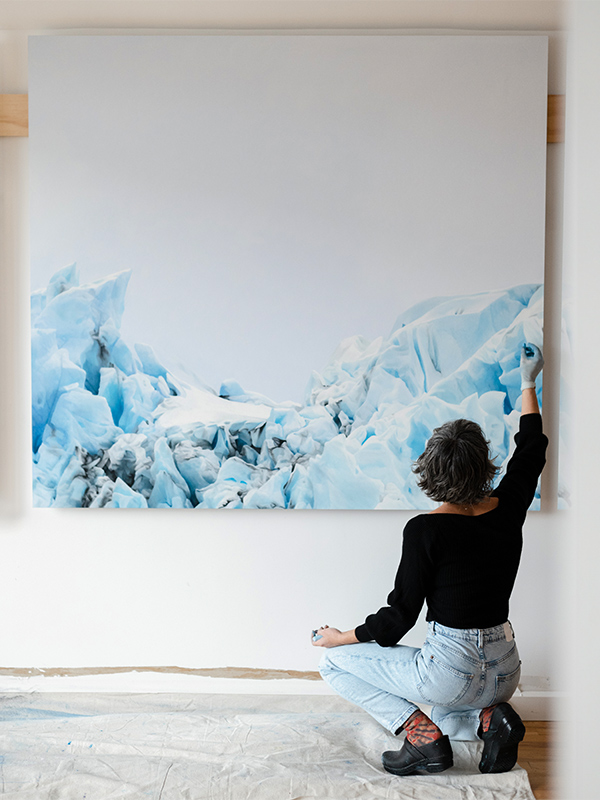
The fascination of glaciers
FACES: You once said that glaciers indicate the future and the past. What do you mean?
Zaria Forman: The air bubbles trapped inside the glaciers tell us a lot about the history of our planet. The crackling sound these bubbles make when the ice melts is one of my highlights! Each of these bubbles is a treasure trove of information that scientists can decode. I spoke to John Higgins, a professor of geosciences at Princeton. He uses these bubbles inside the ice to determine the age of the ice – which is often estimated to be several hundred thousand years old. Using careful chemical measurements, he and his colleagues determine the local temperature and use the amount of carbon dioxide and methane to reconstruct the composition of the ancient atmosphere from the time when the ice was formed. This data helps scientists to understand how and why the Earth’s climate has changed in the past and to assess what this could mean for our future.
FACES: Do you have a specific workflow when you create one of your images, and do you know at the outset what you want the final result to look like?
Zaria Forman: I always start by visiting a place and then let my memories and photos inspire me. My works are always very large, sometimes up to 3.5 meters wide. Then I start with a simple pencil sketch so that I have some main lines to follow when painting. I then layer the pigments onto the paper and smudge them with the palms of my hands and my fingers. I use soft pastel, which feels as dry as charcoal. Some would say I paint, but I always call it drawing. One of my trademarks is the abrupt transition from one pastel color to another. Sometimes I reinvent the water or the sky, change the shape of the ice or combine several images to create a completely new, balanced composition. However, 90 percent of the time I remain faithful to the scene that I observed outside in nature and that has burned itself into my memory.
FACES: How do you describe the artwork you created for Vacheron Constantin and what emotions do you want people to experience when they look at it?
Zaria Forman: For the Vacheron Constantin exhibition at the Harpa Center, I created several works on different media. My pastel drawing on paper shows a scene at Diamond Beach. The enormous zoom allows us to better understand the depth of the ice and grasp its vulnerability. I also documented the melting of the ice in a video. Here you can see the foaming waves crashing against the shore and the ice, and the warm sunlight illuminating the ice crystals in very different ways. The Fellsfjara prototypes symbolize in an abstract way what can be seen in the video. My idea was that viewers could walk around the works to experience the sunlight refracting in the ice and its dance and movement. Psychology teaches us that people act and make decisions based on their emotions. Studies prove that art influences our emotions. I show the beauty of what we absolutely must protect, instead of once again emphasizing the terrible effects of climate change. I hope to inspire people to protect these landscapes with my art and by pointing out their beauty.
Zaria Forman
For Vacheron Constantin and its Overseas collection, American Zaria Forman traveled to Iceland to gather inspiration for her art. She processes her impressions on canvas and as installations, which can be seen as part of the “Fellsfjara Preview” exhibition at the Harpa Center in Reykjavik.
harpa.is
Here you can see what Zaria Forman is up to.
Art is everywhere. Here we show you the greatest works of art that aren’t hanging on the wall in a gallery.
Photos: © Vacheron Constantin


